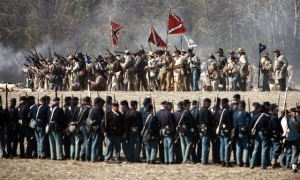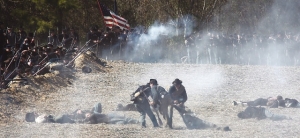The battle: Take Two
By Steve Herring
Published in News on March 21, 2010 1:50 AM

News-Argus/MICHAEL BETTS
Union soldiers face off against their Confederate counterparts at the Battle of Bentonville re-enactment Saturday.

Union re-enactors drag a wounded soldier back behind their lines during the fierce fighting at Saturday's re-enactment of the Battle of Bentonville.

Confederate re-enactors march into battle during Saturday's re-enactment of the Battle of Bentonville. The event drew nearly 4,000 participants and almost 40,000 spectators.

News-Argus/BOBBY WILLIAMS
Re-enactors fire a cannon during Saturday's re-enactment activities at Bentonville Battleground.
BENTONVILLE -- Nearly 4,000 re-enactors are in this rural Johnston County community this weekend to recreate the Civil War Battle of Bentonville -- an event expected to draw close to 40,000 people to the site and pump millions of dollars into the county's economy.
Re-enactors from up and down the Eastern Seaboard as far north as Canada and from as far west as Texas are taking part in the event. Tickets were even pre-sold to people as far west as Montana.
The re-enactment that got under way Saturday continues today. All activities, except for the battle re-enactment -- lectures, house tours, demonstrations and more -- are free to the public. Tickets for the battle re-enactment are $10 for adults and $5 for children. Children 6 and under are admitted free.
It will run today from 9 a.m. to 5 p.m. with the re-enactment of the Last Grand Charge of the Army of Tennessee and Morgan's Stand from 1:30 to 2:30 p.m.
The site is located on Secondary Road 1008 in southeastern Johnston County just northeast of Newton Grove.
Bentonville was one of the last major Civil War battles, with more than 80,000 troops engaged across 6,000 acres of farm land. The Union forces were commanded by Gen. William T. Sherman and the Confederates by Gen. Joseph Johnston.
Crom Lennon, 95, of Oak Island, and Greene County native Sam Newell were among the more than 200 people crammed into a tent to listen to historian Mark L. Bradley of Raleigh, author of "Last Stand in the Carolinas: The Battle of Bentonville," talk about the battle for the Morris Farm -- the battle that was re-enacted Saturday afternoon.
Lennon's grandfather, Ira Lennon, who was 17 at the time, fought in the battle as a member of the Confederates' Junior Brigade that was under the command of Newell's great-great-grandfather, Col. John H. Nethercutt.
"The Confederacy was scraping the bottom of the barrel by the spring of 1865," Bradley said during his comments. "You have the Junior Reserves. They had the Senior Reserves, men 45 to 55. These were men considered too old for front-line military service.
"As one Confederate wit put it, the Confederacy was 'robbing the cradle and the grave in order to stop Sherman.'"
"Oh, I enjoyed it very much. I have been here before," said Crom Lennon, who at one time worked with CP&L (now Progress Energy) in Goldsboro.
"He was very young when his grandfather died so he didn't really remember him talking about anything like that," said Lennon's nephew, Tom Lennon. "His (Ira Lennon's) first battle was the first Battle for Fort Fisher. Then he was here. We think he was at Kinston, but we are still tracking and researching that."
Newell also is trying to find out more about his ancestor.
"He was field promoted to brigadier general to command that brigade," Newell said. "But he was originally a colonel with the 66 North Carolina. He was temporarily taken away from the 66 and given command of the Junior Reserve.
"I have been trying to do some research on him. An interesting story about him is that on March 30, Joe Johnston sent a telegram to Lee in Virginia requesting that Nethercutt and one other man be permanently made generals. Petersburg fell April 2, so whether or not Lee ever responded to that, I do not know. We would like to call a story about Nethercutt 'Lee's Last General' because it was so close to the end of the war."
Newell said he enjoyed the presentation, but wished it could have been more detailed since the battle lasted for three days.
"I think it is just a wonderful event," he said. "I was impressed with the size of the organization and I call tell from the size of such a large crowd that everybody is having a great time and came to learn about history. I teach history at Epps Middle School in Greenville."
The stage for the Battle of Bentonville was set in December of 1864 when Sherman captured the port city of Savannah, Ga. to complete his march to the sea from Atlanta, Bradley said.
"Sherman is looking for the next move on his chessboard and he looks north to Richmond, the capital of the Confederacy," he said. "In order to end the war as expeditiously as possible, Sherman knows that he has to link up with forces under the Union general in chief, Lt. Gen. Ulysses S. Grant who is besieging Lee's forces, the Army of Northern Virginia, around Richmond and Petersburg."
Sherman realized that joining the two forces would result in a quick end to Lee's army, he said. Sherman entered South Carolina on Feb. 1, where vastly outnumbered Confederate forces split to protect the port city of Charleston to the east and Augusta, Ga. to the west, giving Sherman virtually a "free pass" through the state, Bradley said.
Lee picked Johnston as the one to try and stop Sherman, whose first objective was Fayetteville although he was heading towards Goldsboro to link up with other Union forces. Just 36 days after Bentonville, Johnston surrendered his men at the Bennett farm house near Durham on April 26, 1865.
"The first time I came out here I had just read an article on the Battle of Bentonville and it struck me this is really a large battle," Bradley said in an interview. "I came out to the battlefield and saw just how huge the battlefield was and I realized the 20 to 30 page article just scratched the surface, that there was a lot more to be found about this."
Bradley spent about four years of research combined with about three years of writing to produce the book.
"I think the fact that the Confederates were able to launch a major assault against a federal field army just three weeks before Lee surrendered at Appomattox Courthouse, that is really amazing," he said. "This (battle) is also the culmination of Sherman's Carolinas Campaign. This is what really wraps it all up. Sherman's campaign is a success if he can get to Goldsboro, but if he cannot break through here at Bentonville or if he takes a big hit here, then he has to consider it a failure -- his campaign has not achieved what he set out to do."
"They have been working on this for about a year and a half," said Megan Phillips, programs coordinator for the site. "Of course because of state budget restrictions we had to do a big justification on holding the event at a state historic site.
"The economic impact on Johnston County from this event is enormous. We are expecting 30,000 to 40,000 people over the weekend. We are probably close t0 4,000 re-enactors."
Vendors from across the state were on hand selling 19th-century style items. Civilian re-enactors set up camp to perform domestic demonstrations such as cooking and sewing. Spectators could walk through the military camps right up to just prior to the start of the battle. The Harper House which served as a field hospital during the battle was open for tours as was the visitors' center.
Bentonville Battlefield State Historic Site is an agency of the Division of State Historic Sites in the N.C. Department of Cultural Resources. Information is available at www.ncculture.com.
